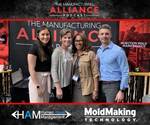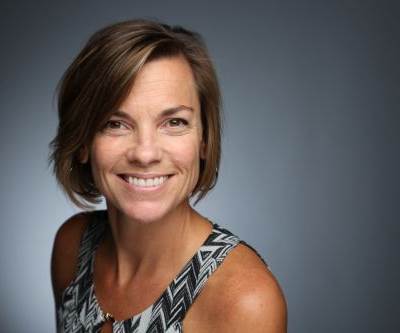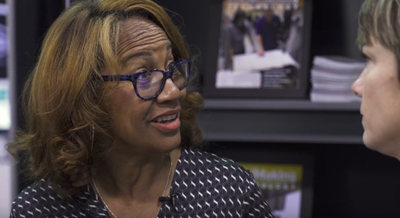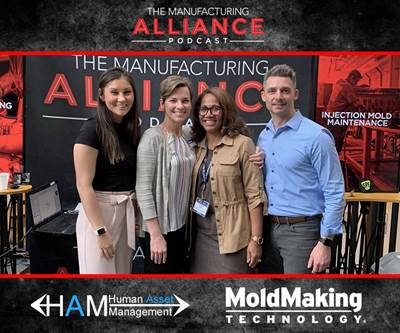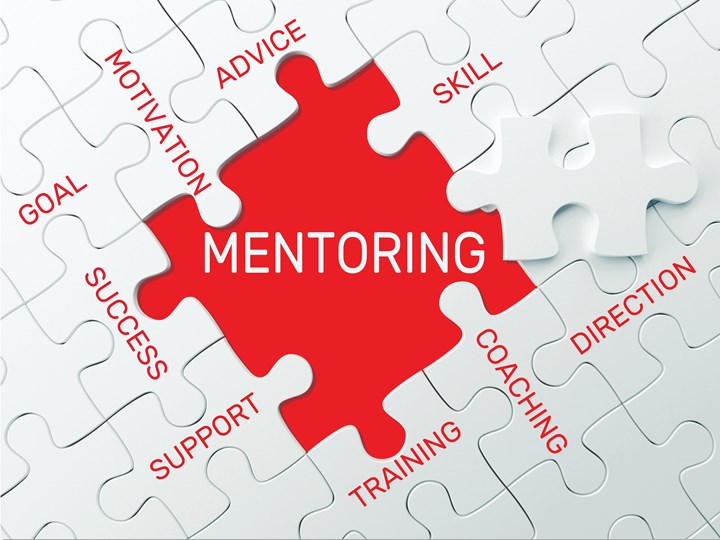
It all started in 2017 at Amerimold during a casual conversation with Marion Wells of Human Asset Management about the skills gap and the needs of the next generation entering the workforce. Following that discussion, we partnered up and launched a workforce development survey to gauge where the moldmaking industry stood when it came to workforce readiness. The result was a panel discussion at Amerimold in 2018 that revealed some key strategies. However, after the presentation, a few next-generation attendees approached us, expressing a new challenge that they were experiencing.
Now that they were working within the industry for a few years, they were struggling with understanding the older, or seasoned, generation. And, as it turned out, the more seasoned generation was feeling the same way. So, to make a long story short, we decided to continue our workforce readiness project and launch an informal pilot cross-generational mentorship program to help get the conversation started, to rule out some misconceptions about mentoring and to offer some strategies. We identified a pilot group, developed the structure, launched the program and documented their journeys so that we could share their experiences and takeaways with the industry.
My role in all of this was an observer, a moderator, a motivator and a facilitator. I checked in six times over six months through conference calls to hear how each pair was moving along in the program toward their goals.
Observations
This role proved to be valuable to each of the participants and allowed me to identify some key takeaways of a pilot cross-generational mentorship program:
- Mentoring is not one-sided. Generations can truly mentor each other or act as resources for each other.
- Making time is vital.
- Busyness cannot be an excuse for lack of participation.
- An ice breaker is a crucial first step.
- Maintain focus on professional/career development within your current job.
- Integrating a form of check-in with the person’s team/company is helpful if the mentor/resource is external.
- Allow time for reflection and any necessary recalibration.
- Time to process is necessary.
- Vulnerability, honesty, and trust are essential to the process.
- Participants having no prior relationship may be the key to success.
- Working for the same company has its pros and cons.
- Age and gender do not impact the success of a mentorship relationship.
- Both generations have more in common than they both thought.
- Self-awareness is an immediate outcome.
- Mentorship allows more effective “venting” because both parties help each other to calibrate.
- Mentorship is not one-size-fits-all—some people require a plan and formal communication; others require structure and facilitation while others do not.
Course of Action
So, my question to you is: Are you ready to start your pilot mentorship program? If so, here is some initial guidance. First, identify the purpose of your pilot mentorship program. For example, maybe you want to attract new talent, increase employee retention, or change your company culture. Then determine the structure: formal or informal.
Formal mentoring is structured based on a specific business objective, measured and brings people together based on compatibility. A formal relationship typically lasts for a specified amount of time. It then formally ends (although sometimes a mentoring pair may decide to continue their mentoring relationship informally at that time). Informal mentoring, by definition, has very little structure or is loosely structured based upon the chemistry between two partners to be involved in a mentoring relationship. Informal mentoring will sometimes even develop into a long-term friendship. You might consider a blended version of both, as we did.
Next, set some boundaries. You don’t want people talking about everything under the sun; you want participants to be laser-focused on specific topics, which requires a structured format with objectives and agenda topics to guide the conversation. For example:
Objectives:
Career aspirations
Goals of mentor sessions
Agenda/Topics:
Skill Development
Goal Setting/ Career Planning
Problem Solving
Networking
To get started, hold an icebreaker. This session proved an invaluable exercise as it allowed both the mentor and mentee to discover something about each other and to establish trust and understanding. The icebreaker requires each party to do a little homework and assess what each knows about the other. In some instances, participants discover they have similarities as they get to know each other in that first session.
The format is simple.
- Pretend you have been asked to introduce your mentee or mentor. Based on what you know about each other, write a short introduction piece to share during the first session.
- Mentor and mentee should come to the first session prepared with a written introduction of each other and read your introduction to your partner. You might start with, “If I had to introduce you to a group based on what I know about you, here’s what I would share ...”
- Complete the “Who I Am” questions below to share, helping to fill in the gaps of who you are that the respective introductions won’t have. Share the completed document after you have completed your introductions. You can exchange the documents via email before the start of your session.
“Who I Am” Survey
- My most important role in life is as a …
- At work, I …
- My favorite way for me to spend my free time is …
- One thing about me that is important for people to know is …
- Some of the strengths that I will bring to the relationship are …
- What I want to learn about myself through this mentorship relationship is …
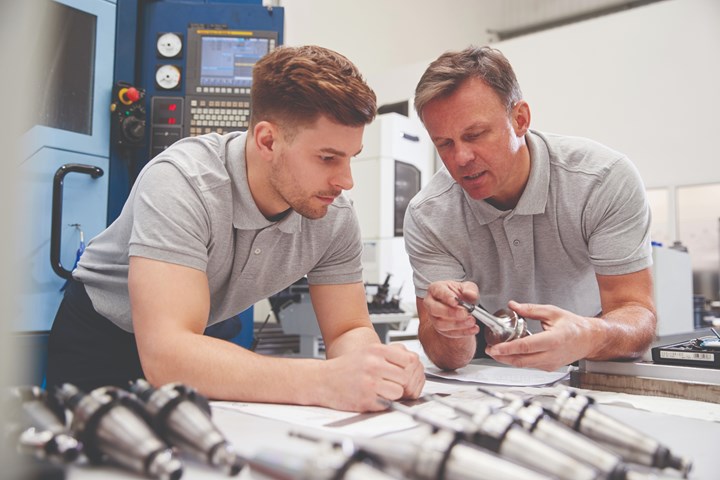
If you are ready to launch your pilot mentorship program, the first step is identifying the purpose of your pilot mentorship program—attracting new talent, increasing employee retention, or changing your company culture, for example.
Success Factors
A key to success I observed in the pilot group was facilitation. Identify someone to hold the teams accountable to ensure goals are established and to make sure all parties understand the structure of the program. This person also sets a deadline and checks in with the teams regularly. A facilitator pops in and checks on both parties to make sure that everything is going okay, gives a nudge, or helps to get the teams reinvigorated. He or she also conducts a comprehensive halfway checkpoint to understand any challenges a team may be facing to determine if reassessment or recalibration is necessary.
Setting a time to assess the need for recalibration was also very important. The discovery process during the mentoring journey is one of self-awareness. As you get to know yourself and the other individual, what you thought was the purpose of your mentoring exercise may go completely sideways, and up and down, so you have to be able to pivot at the appropriate moment.
More than one pair in our pilot program stated that the halfway point recalibration on goals was essential because you may have gone down the wrong path or chosen an inappropriate goal. This is where the facilitator role comes into play. Conducting regular checkpoints builds trust and allows participants to be vulnerable and honest about what they were struggling with during the program so they can recalibrate.
Lastly, it is essential at the program’s completion to hold a final session where teams can think retrospectively about their journeys and share how it worked, what they learned and if they want to continue the relationship. The evaluation process helps determine what worked and what didn’t work.
The program’s end may not mean the end of the relationship. Informal mentoring can continue if both parties agree, and some relationships come to a natural end when a mentee learns enough to be independent of specific mentors. Also, new mentoring relationships with others may be more beneficial than continuing an exhausted relationship. A pilot program can help to assess how mentoring works before launching a formalized program.
I believe that every shop is doing something whether they call it a mentorship or not, so I hope the main takeaway of our pilot mentorship program is that shops will feel encouraged to formalize their effort and to invite other individuals to participate in mentorship.
Related Content
Making Quick and Easy Kaizen Work for Your Shop
Within each person is unlimited creative potential to improve shop operations.
Read MoreHow to Foster Innovation Through a Culture of Education, Mentoring
Dynamic Tool Corp. shares its strategy for building a team with the right attitude and aptitude to deliver innovation that meets customer expectations.
Read MorePredictive Manufacturing Moves Mold Builder into Advanced Medical Component Manufacturing
From a hot rod hobby, medical molds and shop performance to technology extremes, key relationships and a growth strategy, it’s obvious details matter at Eden Tool.
Read MoreMMT Chats: The Connection Between Additive Manufacturing Education and ROI
This MMT Chat continues the conversation with Action Mold and Machining, as two members of the Additive Manufacturing team dig a little deeper into AM education, AM’s return on investment and the facility and equipment requirements to implement AM properly.
Read MoreRead Next
What About Mentorship?
MoldMaking Technology steps back to take a broader look at the value proposition of mentoring and launches a pilot mentorship program.
Read MorePlanning for the 2030 Workforce Challenge
Christina Fuges and Marion Wells of Human Asset Management discuss what the year 2030 means to mold builders, the importance of shop culture to workforce development and a collaborative project on mentorship.
Read MorePODCAST: Planning for the 2030 Workforce Crisis
Listen in as I sit down with The Manufacturing Alliance and Marion Wells of Human Asset Management to record a podcast all about our skilled workforce crisis: the 2030.
Read More




